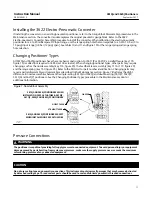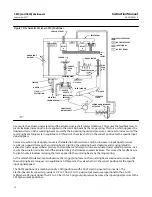
Instruction Manual
D200149X012
3610J and 3620J Positioners
September 2017
17
Installing the 3622 Electro‐Pneumatic Converter
If installing the converter on an existing pneumatic positioner, refer to the Gauge Block Disassembly procedures in the
Maintenance section. The converter module replaces the original pneumatic gauge block. Refer to the 3622
Electro-pneumatic Converter Assembly procedure to install the converter. When calibrating the electro‐pneumatic
positioner for a 4 to 20 milliampere DC input range, use the range spring hole that corresponds to a 0.2 to 1.0 bar (3 to
15 psig) input range [0.8 bar (12 psig) span]. See tables 10 and 11 and figure 15 for the range spring and range spring
hole selection.
Changing Positioner Types
All 3610J and 3620J positioners have the same basic construction. For 3611JP or 3621JP, a parallel flexure (key 179,
figure 13) is added (not required on 585 size 100 actuator). When changing positioner types, other parts may require
changing, such as the nozzle assembly (key 116, figure 25), the feedback lever assembly (key 117 or 170, figure 29),
and the range spring (key 150, figure 25). Refer to the Parts List for part number identification. Changing parts may
require partial disassembly and reassembly as described in the Maintenance section. Figure 7 illustrates the slight
difference in nozzle assemblies between the single‐acting (3610J and 3620J) and double‐acting (3610JP, 3620JP,
3611JP and 3621JP) positioners. See the Changing Positioner Types procedure in the Maintenance section for
additional information.
Figure 7. Nozzle Block Assembly
FLAPPER
OFFSET TAPER
STRAIGHT TAPER
3610J AND 3620J POSITIONERS WHEN
INSTALLED ON 2052 ACTUATORS & 3610JP,
3611JP, 3620JP AND 3621JP POSITIONERS
3610J AND 3620J POSITIONERS EXCEPT
WHEN INSTALLED ON 2052 ACTUATORS
36A5654‐A
A3234‐1
Pressure Connections
WARNING
The positioner is capable of providing full supply pressure to connected equipment. To avoid personal injury or equipment
damage caused by parts bursting from system overpressure, make sure the supply pressure never exceeds the maximum
safe working pressure of any connected equipment.
CAUTION
Do not use sealing tape on pneumatic connections. This instrument contains small passages that may become obstructed
by detached sealing tape. Thread sealant paste should be used to seal and lubricate pneumatic threaded connections.



































